Crack Growth Prediction on Critical Component for Structure Life Extension of Royal Malaysian Air Force (RMAF) Sukhoi Su-30MKM
Abstract
:1. Introduction
1.1. Fatigue Life Evaluation
1.2. Structural Integrity
- (a)
- Su-30MKM Usage Monitoring.
- (b)
- Su-30MKM Condition Monitoring.
1.3. Crack Growth Prediction
- Ultimate static strength and stiffness of defect-free material.
- Material behavior under the rate of change (time-dependent) such as stress rupture, thermal fatigue, creep, and corrosion stress.
- Damage tolerance or fail-safe approach of damaged material for residual static strength and stiffness.
- Safe-life approach of defect-free and undamaged material fatigue.
- Repair procedures, inspection, and maintenance intervals of damaged and flawed material. (Material life.)
1.4. Fatigue Crack Growth Equation under Cyclic Loading
1.5. Fatigue Durability Analysis
- Part 1: Fatigue cycles that generate cracks almost identical to cracks found in service.
- Part 2: The test specimen undergoes loading cycles that represent the aircraft loading profile to generate cracks.
- Part 3: The residual strength that failed post-mortem. The damaged surface is then used for qualitative fractography (Q.F.) to generate growth data.
1.6. Problem Statement
2. Fighter Aircraft Structural Critical Component
- Wing root L.H. and R.H.
- Vertical Stabilizer L.H. and R.H. attachment.
- Horizontal Stabilizer L.H. and R.H. attachment.
- Engine Mounting L.H. and R.H.
- Canard L.H. and R.H. attachment.
- Upper Longeron at Frame No. 18.
Aircraft Wing Critical Location
3. Methodology
3.1. Low Cycle Fatigue Analysis
- The spectrum loading (g-loading).
- Material properties, with fatigue characteristics, either S–N or E–N formulation.
- The component to be analyzed. The component should have actual physical geometry and the component was analyzed to obtain its displacement, stress, and strain result. This is usually performed using a static linear analysis, but other solutions can be used if needed.
3.2. Computer-Aided Design (CAD) on Aerodynamic Model
Analysis of Aircraft Weight Check
3.3. Structure Material Properties
3.4. Crack Growth Analysis Model
Crack Initiation
3.5. Development of the Finite Element Model
3.6. Loading Point on Wing Root Model
- Complete CAD model of the structure. The transferred structure must not have any required clean-up or correction. All clean-up and correction must be performed in N.X. software.
- Assigned mesh on the desired structure model. Hex elements must be used in the model for the area assigned for the crack model. This is required for the crack block system to be implemented.
- All boundary conditions and loading systems must be in the correct locations.
- Fatigue data history is not required from the model. Instead, these data will be implemented in the Zencrack simulation software.
- CAD model input from N.X.
- Material and crack properties allocations.
- Modeling the crack characteristic.
- Assigning the fatigue load history properties.
- Mesh relaxation and boundary transfer representative assignment.
- Zencrack solver interactions and modifications.
4. Crack Growth Analysis Result
4.1. Through Hole Crack
4.2. Through Side Crack
4.3. FEA Analysis on Local Model
4.4. Validation of Crack Growth Prediction and Finite Element Analysis
4.5. Summary of the Crack Model and Fatigue Analysis Result
4.6. Model Validation with Experimental Data
4.6.1. Crack Growth Rate Constants of Specified Materials
4.6.2. Predicted Result Compared with Experiment Data
5. Conclusions and Recommendation
- ZENCRACK was most helpful in inserting cracks with complicated shapes into existing 3D F.E. meshes. The feature of the crack block mesh significantly reduced the meshing time and modeling complexity. In addition, the compatibility with the analysis software such as ABAQUS (Dassault Systems, Boston, USA) was a positive feature, allowing the stress intensity factors to be readily calculated for complex geometries and crack shapes.
- Mechanical and thermal loads could be included in calculating stress intensity and crack growth, although this was related to other crack growth software capabilities.
- The crack growth modeling was based on linear elastic fracture mechanics and was limited to a crack growth analysis in linear elastic domains. In addition, the crack growth law (Paris equation) implemented in ZENCRACK was too fundamental for predicting crack growth in many practical situations.
- The installation of a strain gauge should be performed to validate the simulation data and enhance the capability of Structure Health Monitoring (S.H.M.).
Author Contributions
Funding
Data Availability Statement
Acknowledgments
Conflicts of Interest
References
- Reeves, J.D.; Eveleigh, T.; Holzer, T.; Sarkani, S. The impact of early design phase risk identification biases on space system project performance. In Proceedings of the 2012 IEEE International Systems Conference SysCon 2012, Vancouver, BC, Canada, 19–22 March 2012; pp. 1–8. [Google Scholar]
- Clark, G. Aircraft fatigue life extension: Development of a mid-life rework method based on peening. In European Structural Integrity Society; Elsevier: Melbourne, Australia, 2000; Volume 26, pp. 97–114. [Google Scholar]
- Venugopal, A.; Mohammad, R.; Koslan, M.F.S.; Sayd Bakar, S.R.; Ali, A. The Effect of Tropical Environment on Fatigue Failure in Royal Malaysian Airforce (RMAF) Aircraft Structure and Operational Readiness. Materials 2021, 14, 2414. [Google Scholar] [CrossRef]
- Maksimović, S.; Vasić, Z.; Došić, R. Service Life Extension Program for Aircraft Structures. Sci. Tech. Rev. 2015, 65, 9. [Google Scholar] [CrossRef] [Green Version]
- Padfield, G.D. Flight Simulation in Machine Design and Manufacture; Padfield, G.D., Ed.; Blackwell Publishing: Oxford, UK, 2007. [Google Scholar]
- Olurin, O.B.; McCullough, K.Y.G.; Fleck, N.A.; Ashby, M.F. Fatigue crack propagation in aluminum alloy foams. Int. J. Fatigue 2001, 23, 375–382. [Google Scholar] [CrossRef]
- Jianguo, C.; Junjie, G.; Zhonghai, L.; Liqiu, L.; Jian, G.; Wei, L. The Fatigue Life Prediction Model Research for Aeroplane Structures. In Proceedings of the 2010 3rd International Symposium on Systems and Control in Aeronautics and Astronautics, Harbin, China, 8–10 June 2010. [Google Scholar]
- Alvesa, A.S.F.; Sampayoa, L.M.C.M.V.; Correiaa, J.A.F.O.; Jesus, A.M.P.D.; Moreiraa, P.M.G.P.; Tavaresa, P.J.S. Fatigue life prediction based on crack growth analysis using an equivalent initial flaw size model: Application to a notched geometry. Procedia Eng. 2015, 114, 730–737. [Google Scholar] [CrossRef] [Green Version]
- Xiang, Y.; Lu, Z.; Liu, Y. Crack growth-based fatigue life prediction using an equivalent initial flaw model. Part I: Uniaxial loading. Int. J. Fatigue 2010, 32, 341–349. [Google Scholar] [CrossRef]
- USAF. MIL-STD-1530C Aircraft Structure Integrity Program (ASIP); Department of Defense Standard Practice, United State Air Force: Arlington County, VA, USA, 2004. [Google Scholar]
- Hoeppner, D.W. The initiation of fatigue in aluminum alloys. In Proceedings of the Symposium on the Relation between Heat Treatment, Microstructure and Fatigue in Structural Materials, Atlanta, GA, USA, 17–20 May 1971. [Google Scholar]
- Boyer, H.E. Atlas of Fatigue Curves; ASM International: Novelty, OH, USA, 1986. [Google Scholar]
- Suresh, S. Fatigue of Materials, 2nd ed.; Cambridge University: Cambridge, UK, 1998. [Google Scholar]
- Zhan, Z.; Hu, W.; Li, B.; Zhang, Y.; Meng, Q.; Guan, Z. Continuum damage mechanics combined with the extended finite element method for the total life prediction of a metallic component. Int. J. Mech. Sci. 2017, 124, 48–58. [Google Scholar] [CrossRef]
- Gori, Y.; Verma, R.P.; Kumar, A.; Patil, P.P. FEA based fatigue crack growth analysis. Mater. Today 2021, 200–207. [Google Scholar] [CrossRef]
- Si, Y.; Rouse, J.P.; Hyde, C.J. Potential difference methods for measuring crack growth: A review. Int. J. Fatigue 2020, 136, 105624. [Google Scholar] [CrossRef]
- Geary, W. A review of some aspects of fatigue crack growth under variable amplitute loading. Int. J. Fatigue 1992, 14, 377–386. [Google Scholar] [CrossRef]
- Chakherlou, T.N.; Mirzajanzadeh, M.; Vogwell, J.; Abazadeh, B. Investigation of the fatigue life and crack growth in torque tightened bolted joints. Aerosp. Sci. Technol. 2011, 15, 304–313. [Google Scholar] [CrossRef]
- Sadananda, K.; Vasudevan, A.K.; Holtz, R.L.; Lee, E.U. Analysis of overload effects andrelated phenomena. Int. J. Fatigue 1999, 21, S233–S246. [Google Scholar] [CrossRef]
- Schijve, J. Some formulas for the crack opening stress level. Eng. Fract. Mech. 1981, 14, 461–465. [Google Scholar] [CrossRef] [Green Version]
- Noroozi, A.H.; Glinka, G.; Lambert, S. A two parameter driving force for fatigue crack growth analysis. Int. J. Fatigue 2005, 27, 1277–1296. [Google Scholar] [CrossRef]
- Huang, X.; Moan, T. Improved modeling of the effect of R-ratio on crack growth rate. Int. J. Fatigue 2007, 29, 591–602. [Google Scholar] [CrossRef]
- Ohta, A.; Suzuki, N.; Maeda, Y. Unique fatigue threshold and growth properties of welded joints in a tensile residual stress field. Int. J. Fatigue 1997, 19, 303–310. [Google Scholar] [CrossRef]
- Wheeler, O.E. Spectrum loading and crack growth. J. Basic Eng. Trans. ASME 1972, 94, 181–186. [Google Scholar] [CrossRef]
- Willenborg, J.; Engle, R.M.; Wood, H.A. A Crack Growth Retardation Model Using Effective Stress Concept; Technical Report AFFDL-TM-71-1-FBR; Air Force Flight Dynamics Lab.: Dayton, OH, USA, 1971. [Google Scholar]
- Simpson, D.L.; Molent, L. The Canadian and Australian F/A-18 International Follow-On Structural Test Project; Institute for Aerospace Research National Research Council of Canada: Ottawa, ON, Canada, 2002. [Google Scholar]
- Roth, M.; Sander, K. F/A-18 IFOSTP Fractographic Analysis Report NSD31201-1-1 FT312 68% Spar Shear-Tie Component Fatigue Test; Quality Engineering Test Establishment: Gatineau, QC, Canada, 2006. [Google Scholar]
- Kunz, J.; Siegl, J.; Nedbal, I.; Schijve, J. Fatigue Crack Growth History in Concept of Damage Tolerance of Aircraft Structures. In Proceedings of the International Conference on Damage Tolerance of Aircraft Structures, Delft, The Netherlands, 25–28 September 2007. [Google Scholar]
- RMAF. S2-B/AMP-53-9 (Aircraft Maintenance Publication) (53-Fuselage); Markas Pemerintahan Bantuan Udara, Sistem Grup A, Ed.; Sukhoi Design Bureau: Moscow, Russia, 2009. [Google Scholar]
- RMAF. S2-B/AMP-57-P SU-30MKM Air Vehicle Maintenance Publication (Wing); Markas Tentera Udara, Bahagian Kejuruteraan, Ed.; Sukhoi Design Bureau: Moscow, Russia, 2009. [Google Scholar]
- Faiz, Q.B.M. WBS2440 Aircraft Structural Integrity (ASI) Services Report; CAIDMARK: Damansara, Malaysia, 2018. [Google Scholar]
- Kuntjoro, W.; Ashari, M.S.; Ahmad, M.Y.; Mydin, A.M. Development of Fatigue Life Monitoring of RMAF Fighter Airplanes. In ICAF 2009, Bridging the Gap between Theory and Operational Practice; Springer: Dordrecht, The Netherlands, 2009; pp. 1155–1164. [Google Scholar]
- Wang, Y.; Lv, Z.; Yang, Z. Reliability Analysis of a Wing-Fuselage Attachment Fitting. Aircraft. Des. 2004, 3, 801–808. [Google Scholar]
- Fei, C.W.; Lu, C.; Liem, R.P. Hierarchical model updating strategy of complex assembled structures with uncorrelated dynamic modes. Chin. J. Aeronaut. 2020. [Google Scholar] [CrossRef]
- Institute, B.M. Metallic Materials Properties Developement and Standardization; Battelle Memorial Institute: Columbus, OH, USA, 2017; Volume 2, pp. 235–240. [Google Scholar]
- Moiseyev, V.N. Titanium Alloys Russian Aircraft and Aerospace Applications; CRC Press: Boca Raton, FL, USA, 2006. [Google Scholar]
- Yarema, S.Y.; Grechko, V.V.; Ostash, O.P. Cyclic Crack Resistance to VT20 Titanium Alloy Sheets and Its Anisotropy. Fiz. -Khimicheskaya Mekhanika Mater. 1978, 16, 47–52. [Google Scholar] [CrossRef]
- Underhill, R. F/A-18 IFOSTP Fractographic Analysis Report NSD31201-2-1 FT312 68% Spar Shear-Tie Component Fatigue Test; Royal Military College Canada: Kingston, ON, Canada, 2006. [Google Scholar]
- Hu, W.; Liu, Q.; Barter, S.A. A study of interaction and coalescence of micro surface fatigue crack in aluminum 7050. In Proceedings of the 25th Symmposium of the International Committee on Aeronautical Fatigue (ICAF2009), Rotterdam, The Netherlands, 27–29 May 2009. [Google Scholar]
- Liao, M.; Renaud, G. Fatigue Analysis for CF-18 Component: Wing Fold Shear-Tie Lug; National Research Council Canada: Ottawa, ON, Canada, 2010.
- Taheri, F.; Trask, D.; Pegg, N. Experimental and analytical investigation of fatigue characteristics of 350WT steel under constant and variable amplitude loading. Mar. Struct. 2003, 16, 69–91. [Google Scholar] [CrossRef]
- Ray, A.; Patankar, R. Fatigue crack growth under variable-amplitude loading: Part II-Code development and model validation. Appl. Math. Model. 2001, 25, 995–1013. [Google Scholar] [CrossRef]
- Porter, T.R. Method of analysis and prediction for variable amplitude fatigue crack growth. Eng. Fract. Mech. 1972, 4, 717–736. [Google Scholar] [CrossRef]
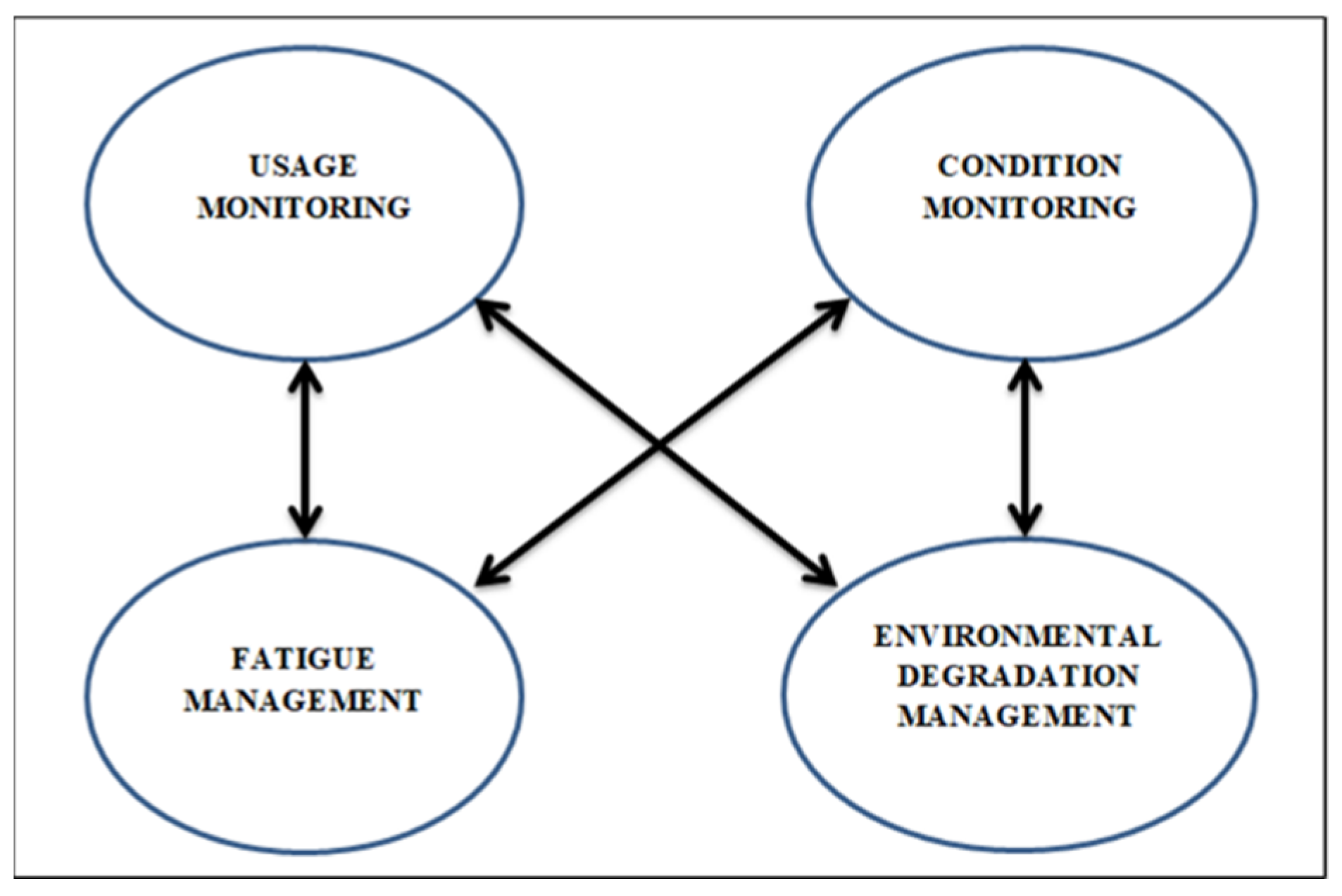

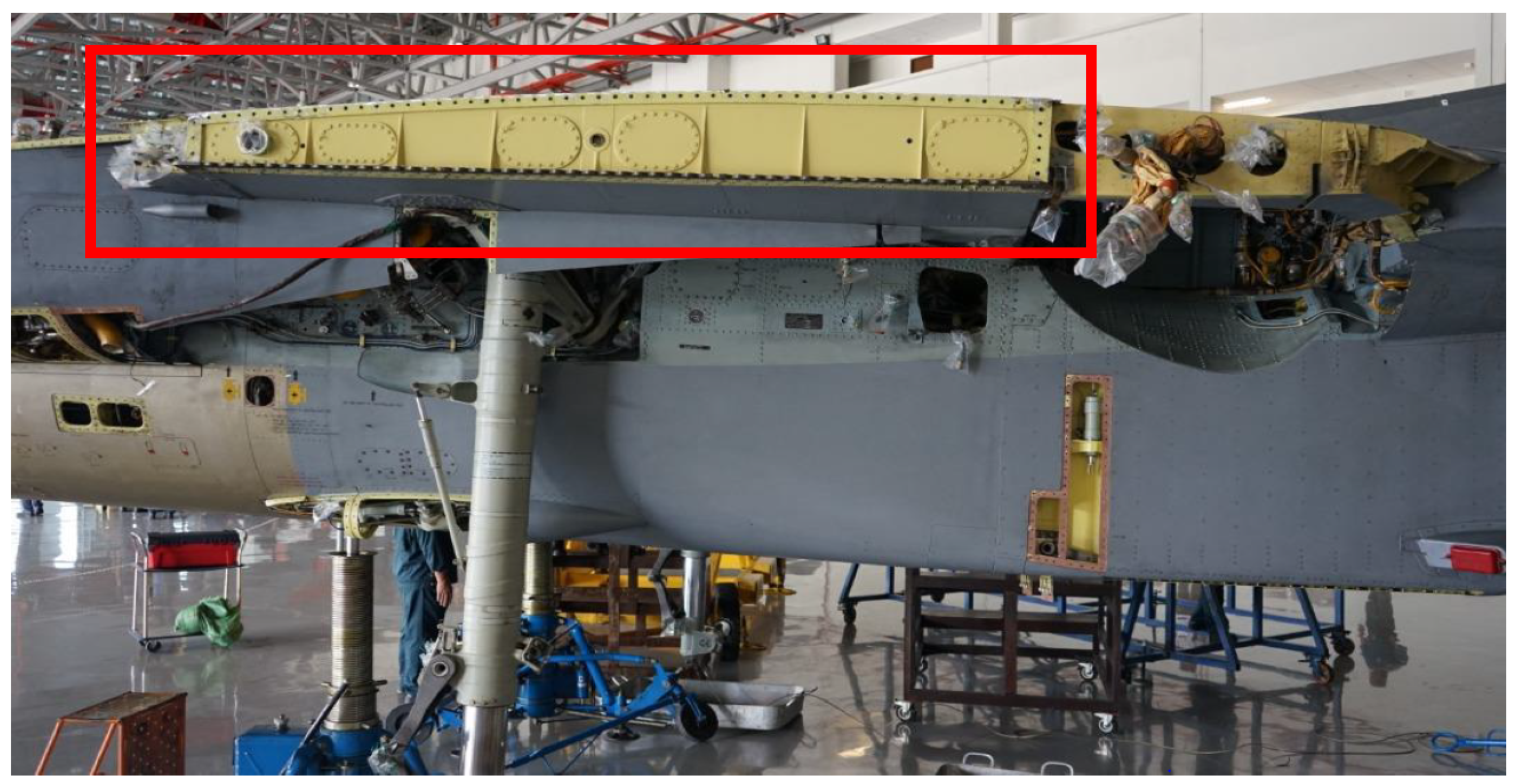


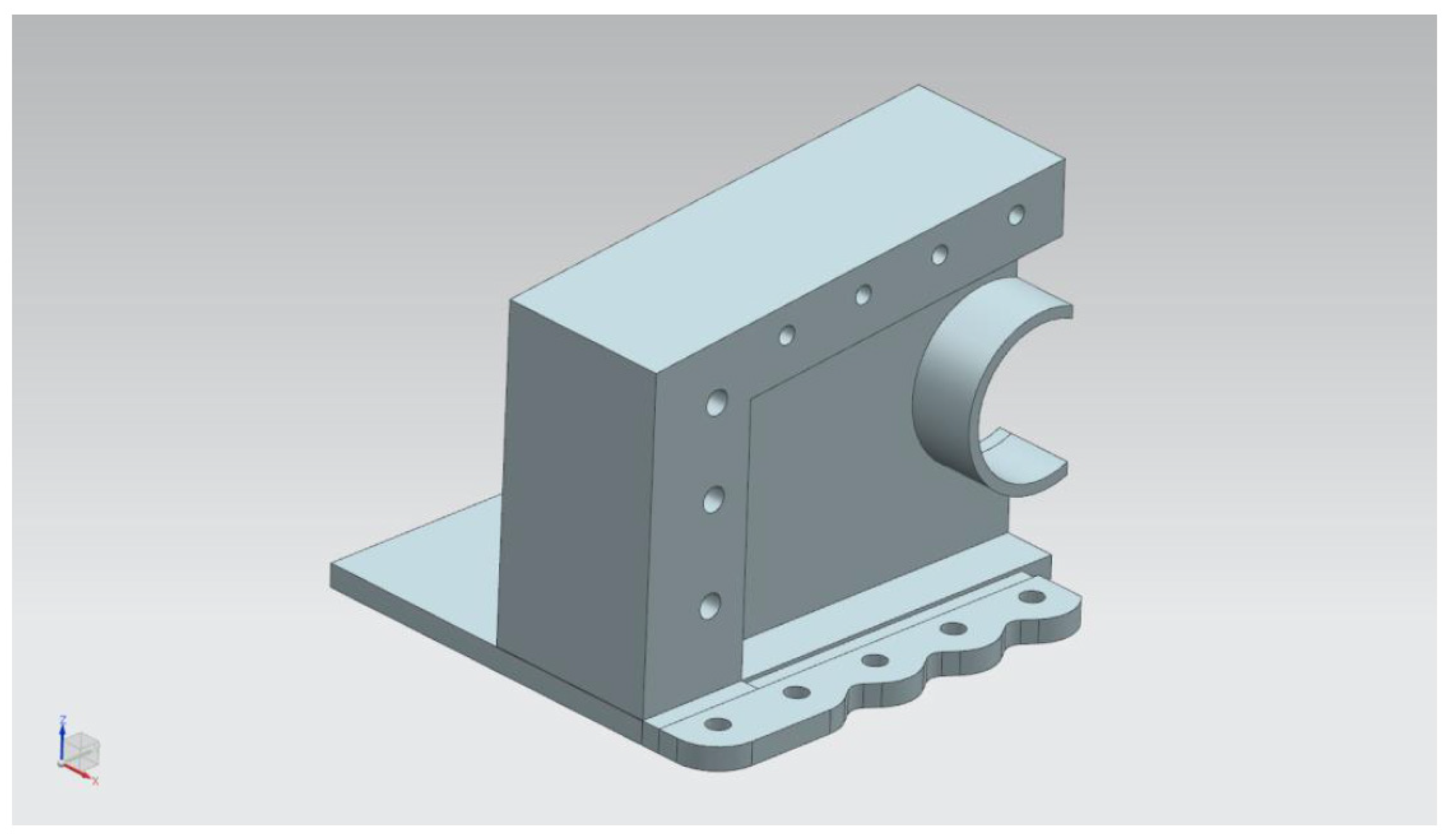

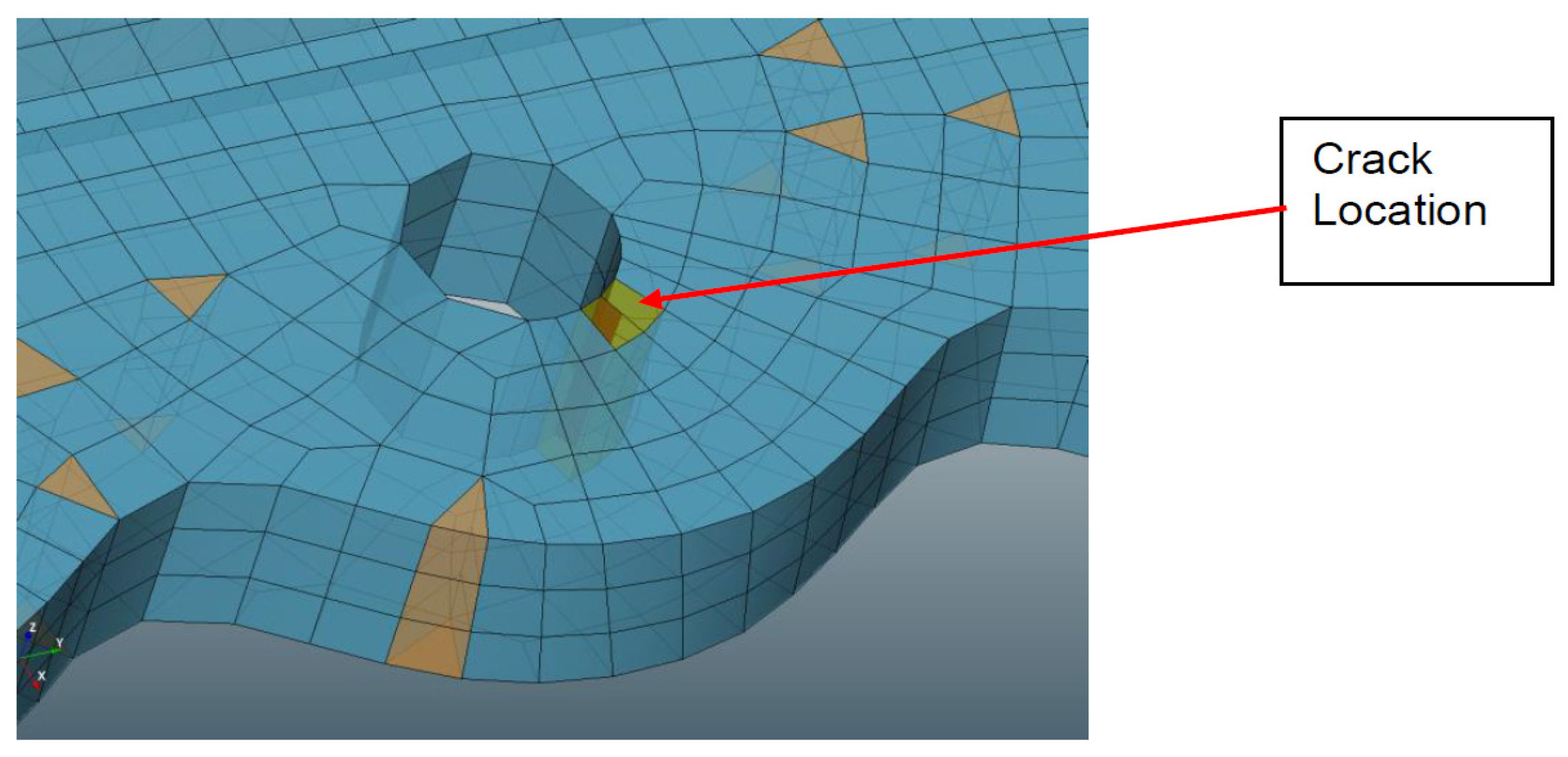
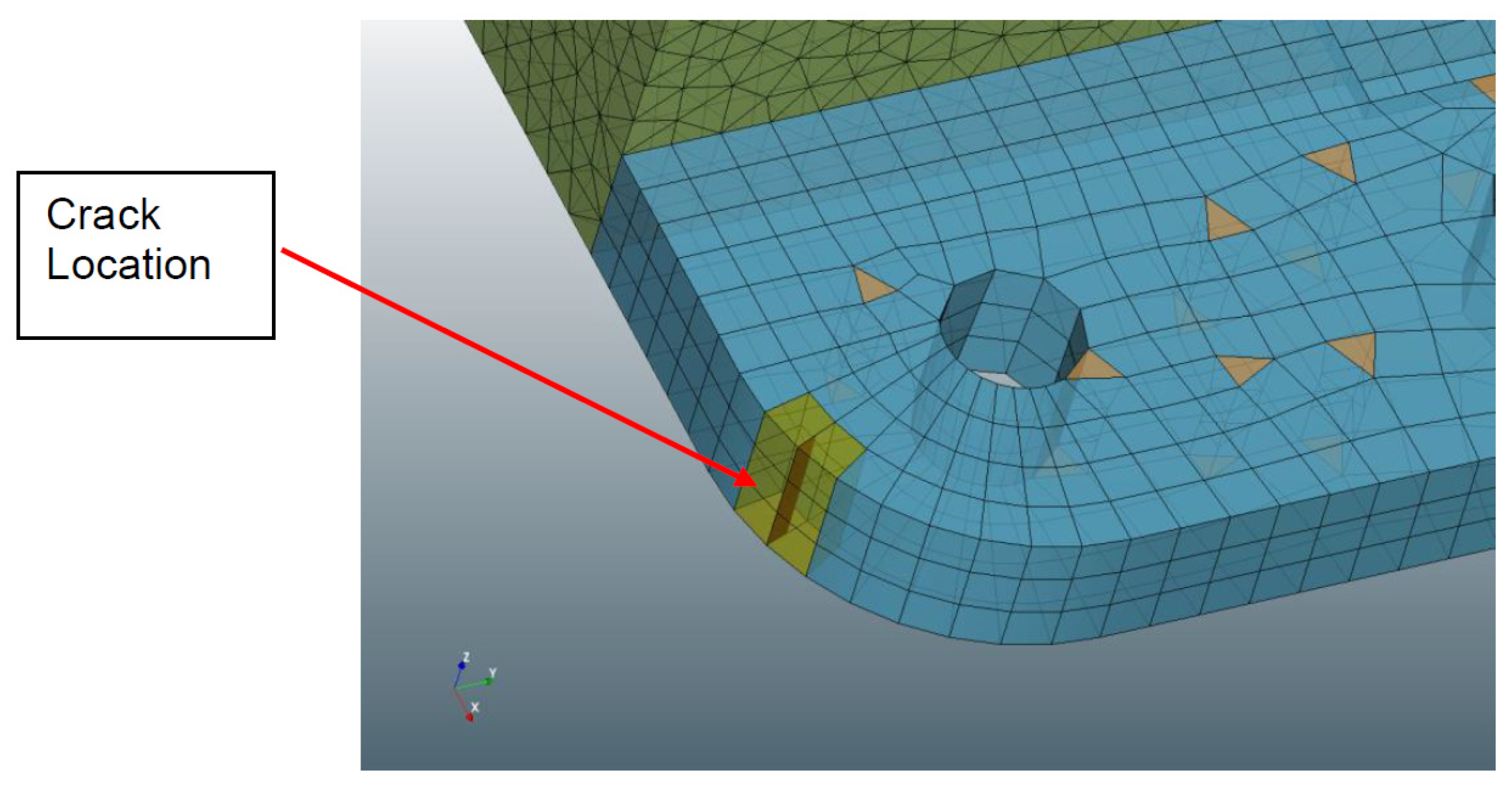

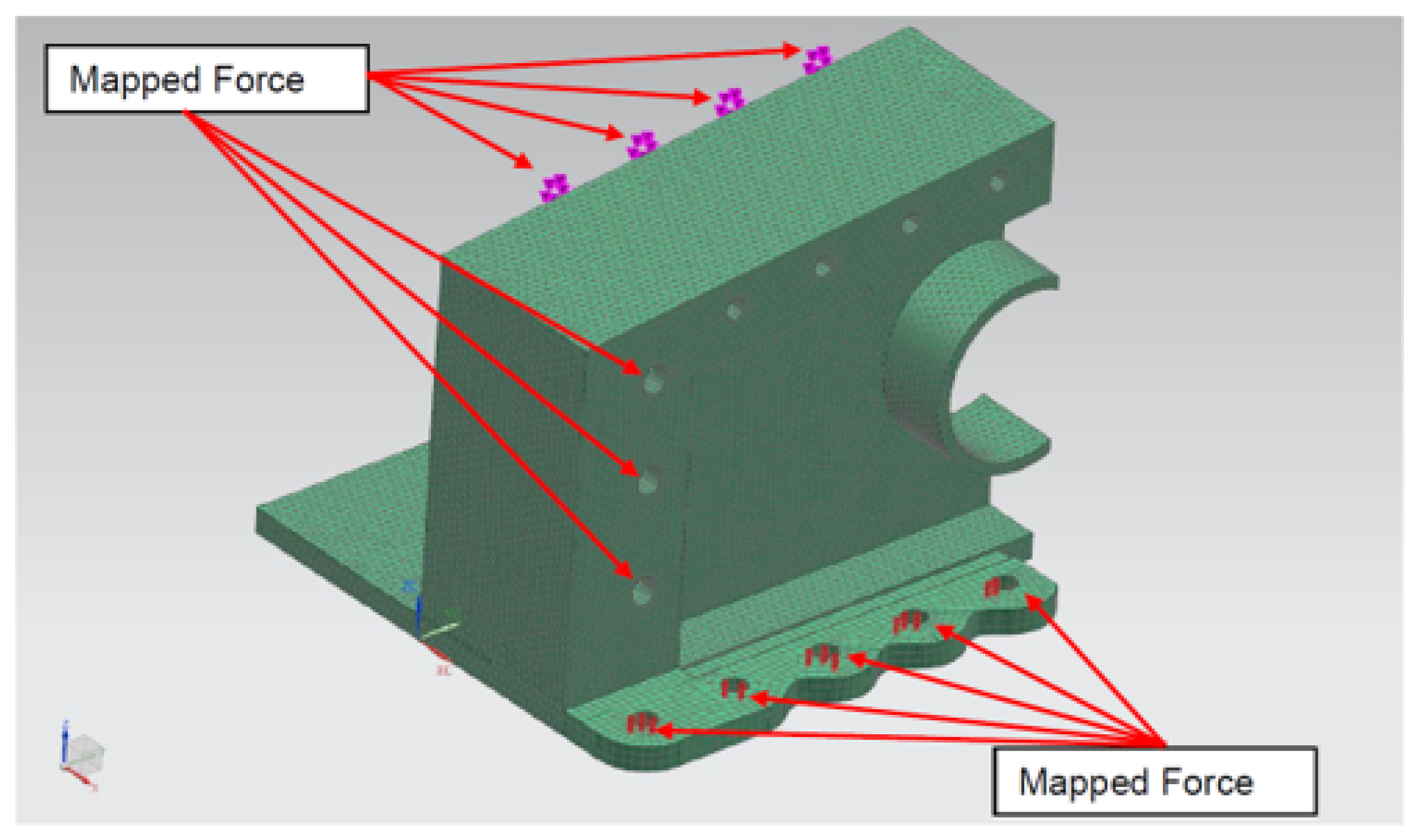
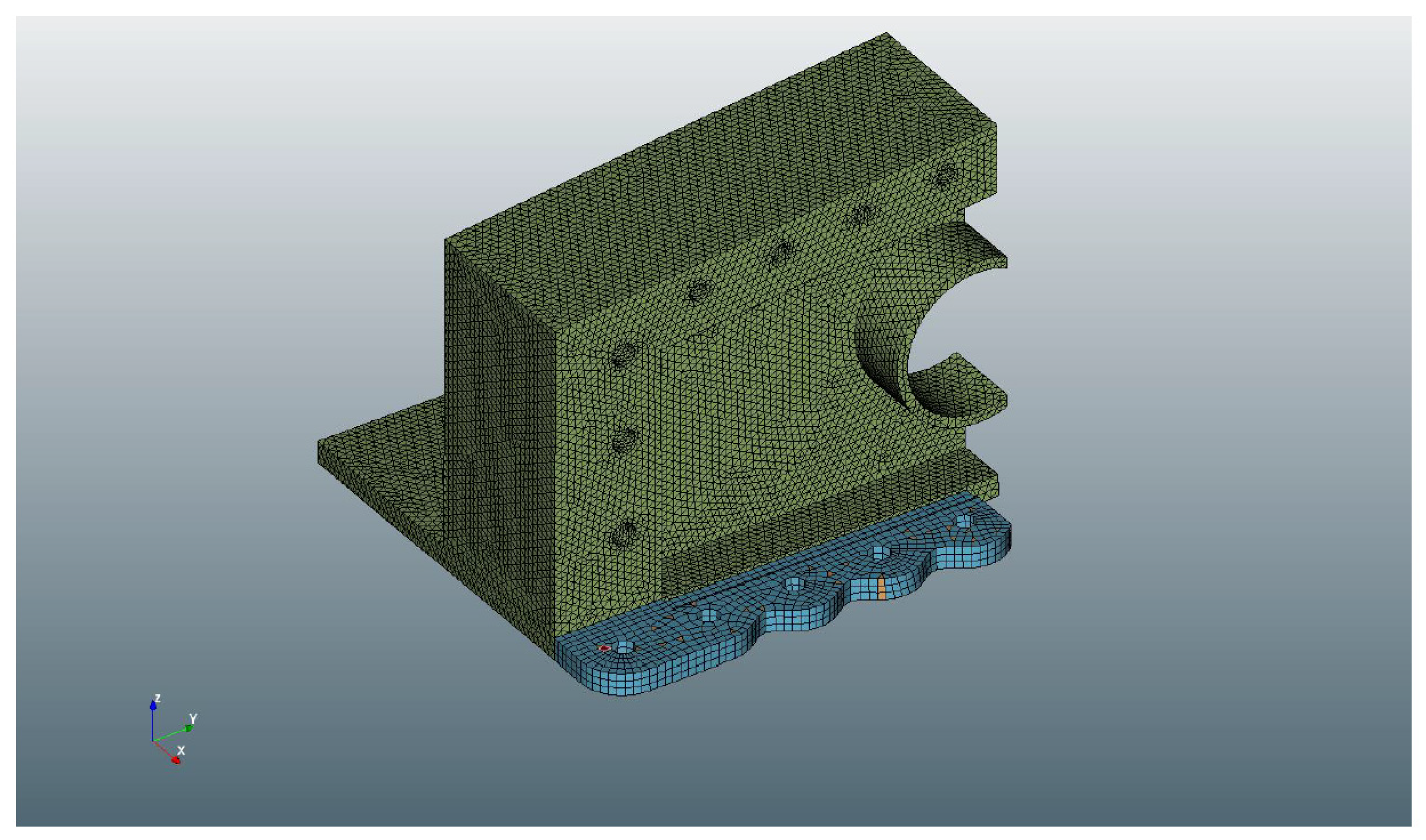
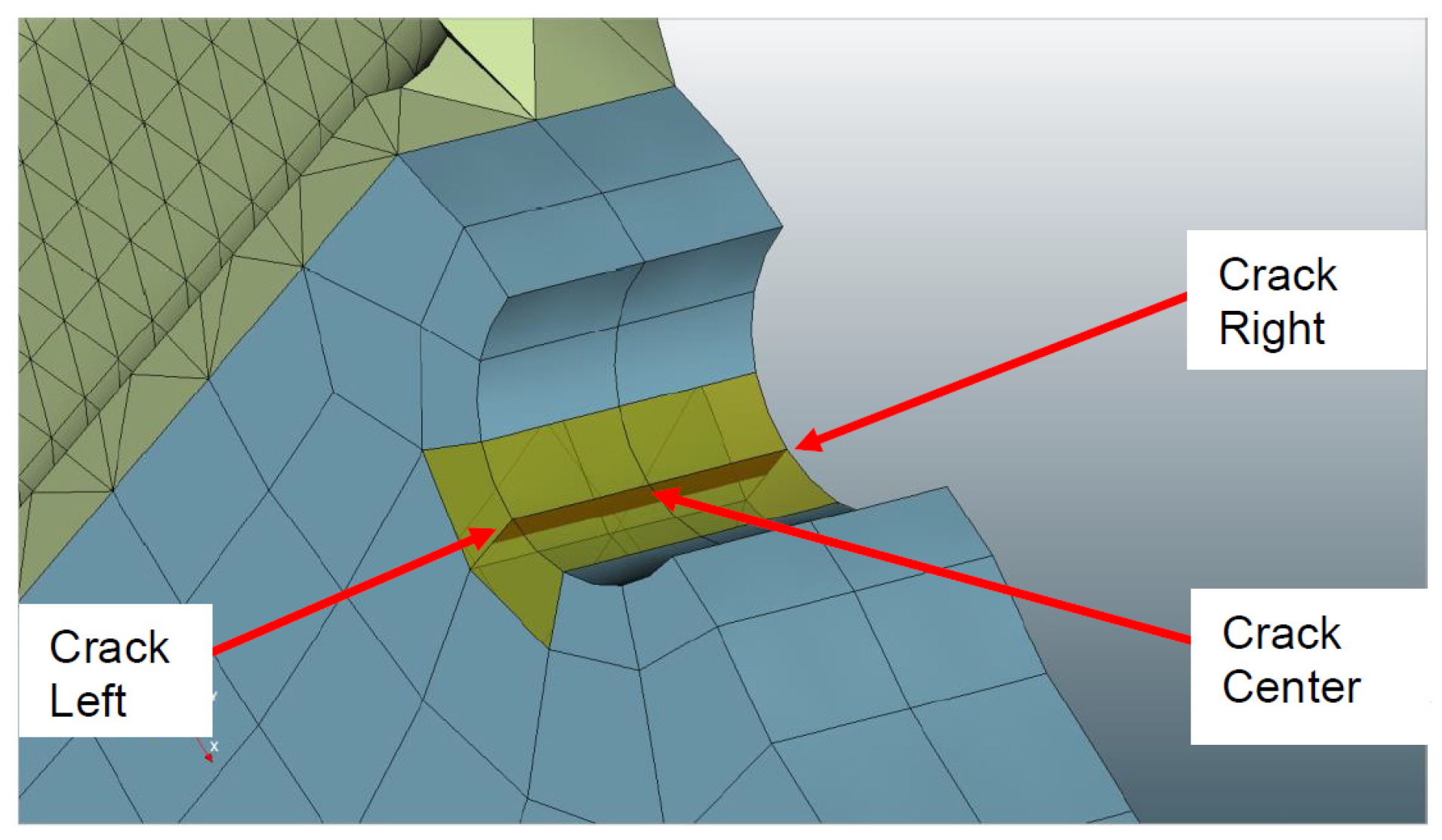

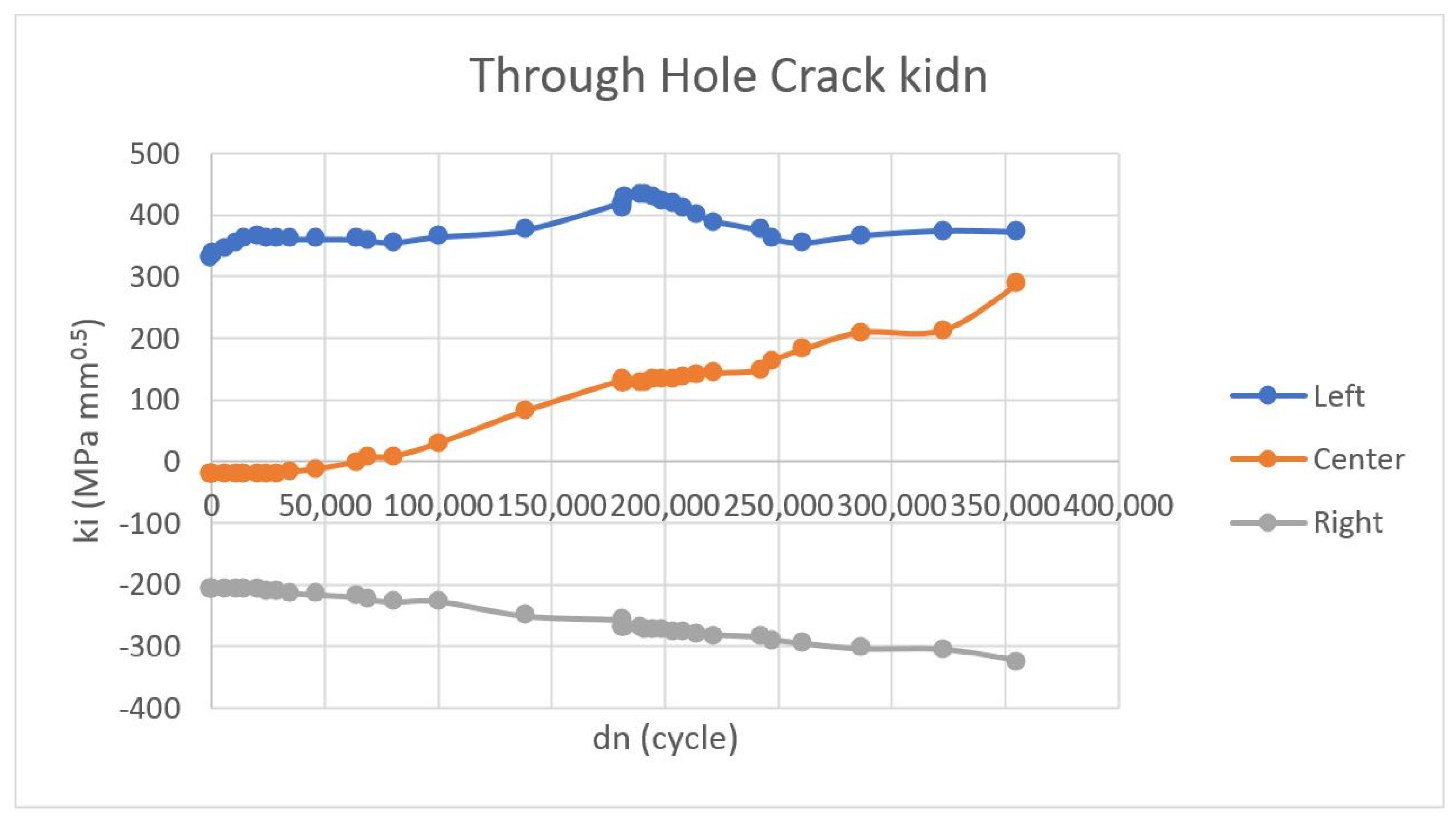

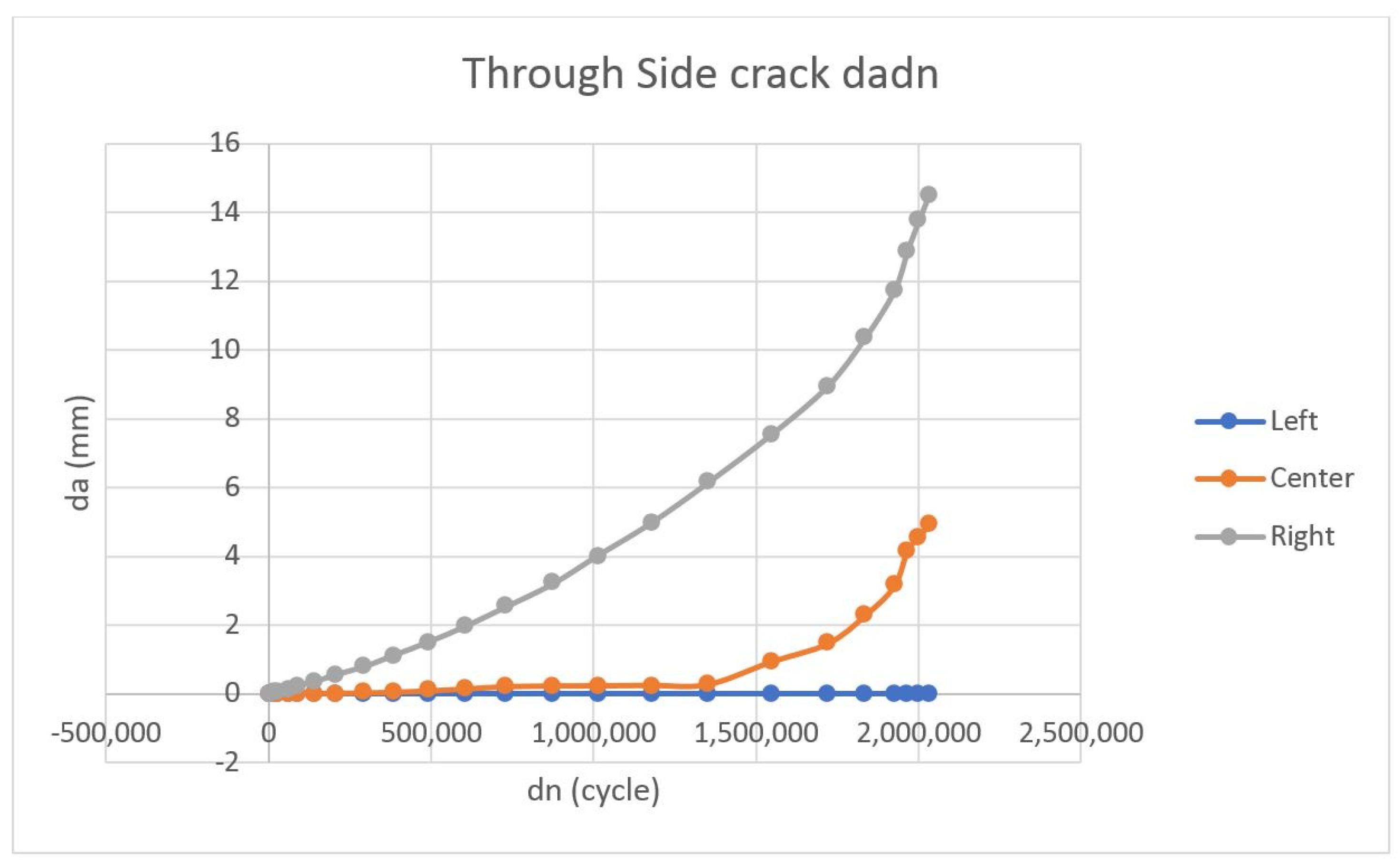
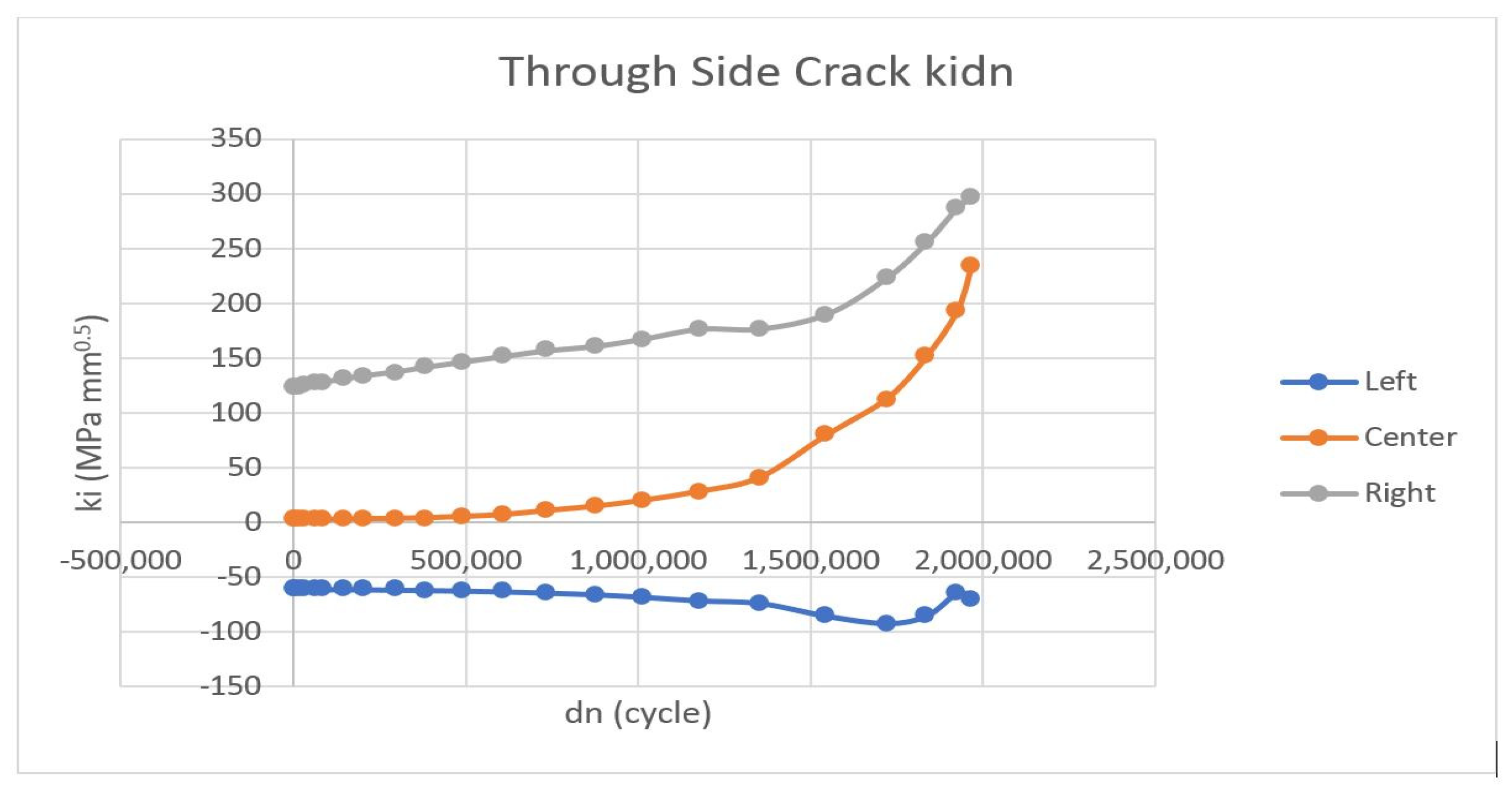
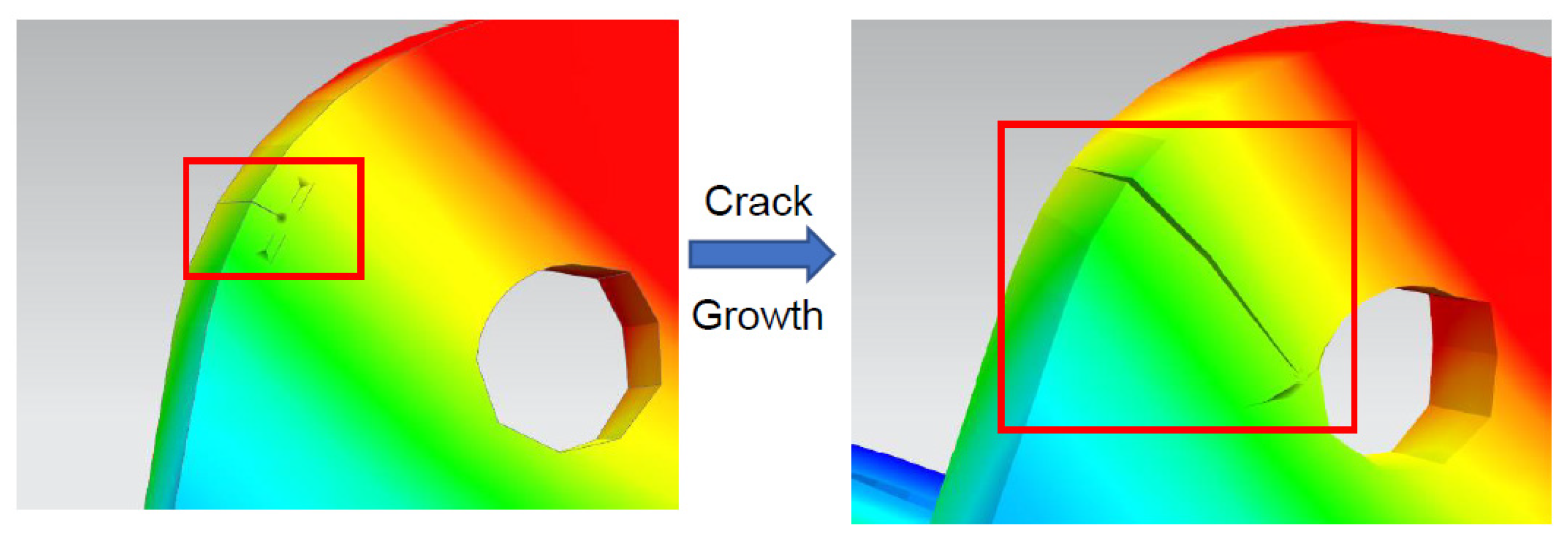
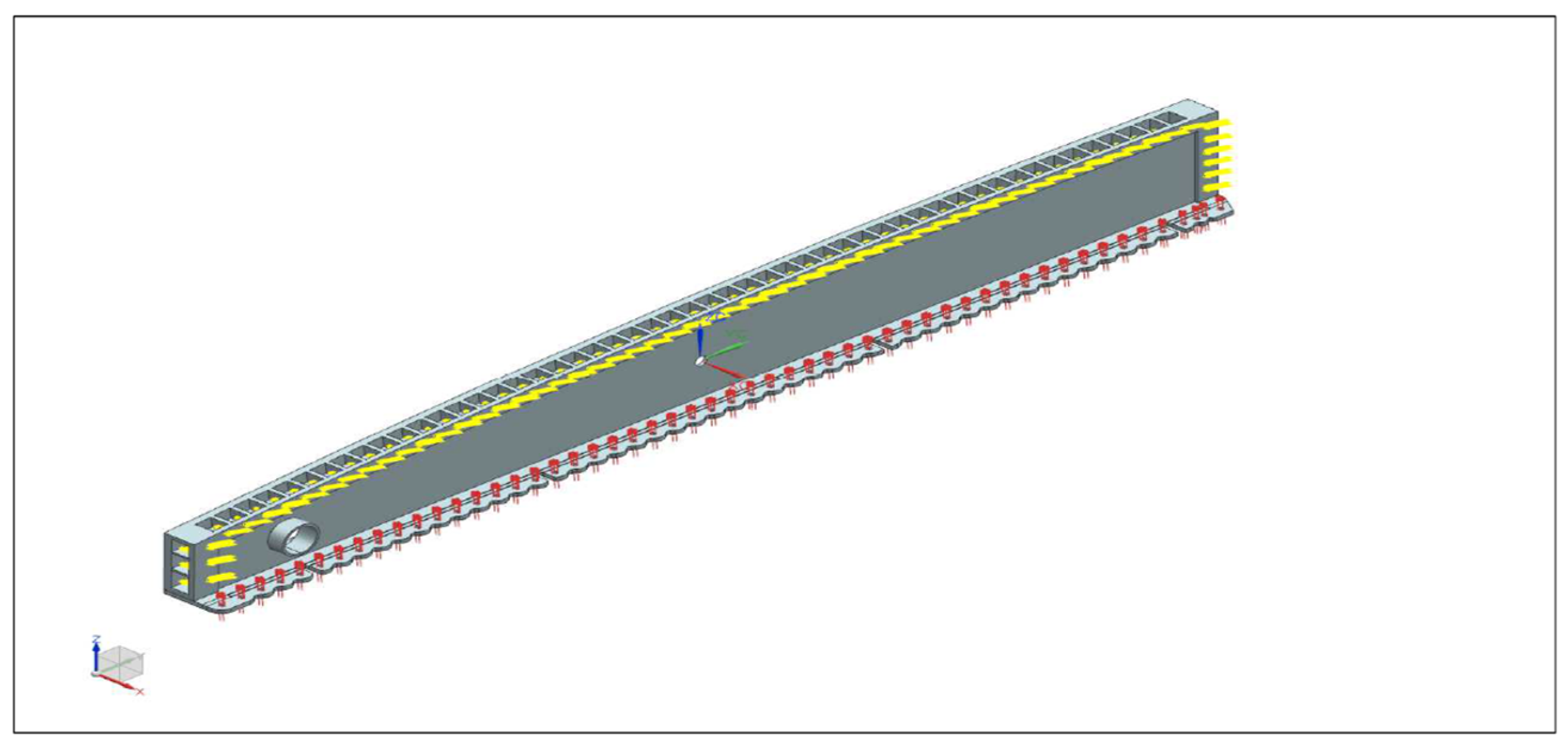


| Description | Weight (kg) | Percentage |
|---|---|---|
| Landing Gear | 1201.702 | 14.12% |
| Flight Navigation Equipment | 1234 | 14.50% |
| Electronics | 1594.23 | 18.73% |
| Aero-Engine | 1570 | 18.45% |
| Total Mass of Components | 8510.1713 | 100.00% |
| No. | Property | Value |
|---|---|---|
| 1 | Young’s Modulus | 121.59 GPa |
| 2 | Poisson Ratio | 0.34 |
| 3 | Yield Strength | 805.58 MPa |
| 4 | Ultimate Tensile Strength | 1103.21 MPa |
| No. | Property | Value |
|---|---|---|
| 1 | C | 7.87 × 10−12 MPa m0.5 |
| 2 | N | 3.04 |
| No. | Property | Value |
|---|---|---|
| 1 | X | 9887 N |
| 2 | Y | −5112.9 N |
| 3 | Z | 8735.2 N |
| No. | Crack Type | Properties | Value |
|---|---|---|---|
| 1 | Through Hole Crack | Crack part lifespan | 413,397 cycles 35 years 6 Month |
| Critical crack length | 16.794 mm | ||
| Maximum cycle reached | 413,397 cycles 35 years 6 Month | ||
| Maximum stress intensity factor | 386.731 MPa mm0.5 | ||
| Maximum sum of da | 16.794 mm | ||
| 2 | Through Side Crack | Crack part lifespan | 1,547,090 cycles 132 years 11 month |
| Critical crack length | 7.53 mm | ||
| Maximum cycle reached | 2,032,310 cycles 174 years 8 month | ||
| Maximum stress intensity factor | 296.704 MPa mm0.5 | ||
| Maximum sum of da | 14.49 mm |
| Specimen Material | σy (MPa) | C | m | n | t (mm) | w (mm) |
|---|---|---|---|---|---|---|
| 7075-T6 (aluminium alloy) | 520 | 6.85 × 10−8 | 3.21 | 0.3 | 4.1 | 305 |
| 2024-T3 aluminium alloy | 315 | 3.0 × 10−8 | 3.1/3.2 | 0.32 | 4.1 | 229 |
| 350WT steel | 350 | 1.5 × 10−8 | 2.8 | 0.5 | 5 | 100 |
Publisher’s Note: MDPI stays neutral with regard to jurisdictional claims in published maps and institutional affiliations. |
© 2021 by the authors. Licensee MDPI, Basel, Switzerland. This article is an open access article distributed under the terms and conditions of the Creative Commons Attribution (CC BY) license (https://creativecommons.org/licenses/by/4.0/).
Share and Cite
Venugopal, A.; Mohammad, R.; Koslan, M.F.S.; Shafie, A.; Ali, A.b.; Eugene, O. Crack Growth Prediction on Critical Component for Structure Life Extension of Royal Malaysian Air Force (RMAF) Sukhoi Su-30MKM. Metals 2021, 11, 1453. https://doi.org/10.3390/met11091453
Venugopal A, Mohammad R, Koslan MFS, Shafie A, Ali Ab, Eugene O. Crack Growth Prediction on Critical Component for Structure Life Extension of Royal Malaysian Air Force (RMAF) Sukhoi Su-30MKM. Metals. 2021; 11(9):1453. https://doi.org/10.3390/met11091453
Chicago/Turabian StyleVenugopal, Arvinthan, Roslina Mohammad, Md Fuad Shah Koslan, Ashaari Shafie, Alizarin bin Ali, and Owi Eugene. 2021. "Crack Growth Prediction on Critical Component for Structure Life Extension of Royal Malaysian Air Force (RMAF) Sukhoi Su-30MKM" Metals 11, no. 9: 1453. https://doi.org/10.3390/met11091453
APA StyleVenugopal, A., Mohammad, R., Koslan, M. F. S., Shafie, A., Ali, A. b., & Eugene, O. (2021). Crack Growth Prediction on Critical Component for Structure Life Extension of Royal Malaysian Air Force (RMAF) Sukhoi Su-30MKM. Metals, 11(9), 1453. https://doi.org/10.3390/met11091453






